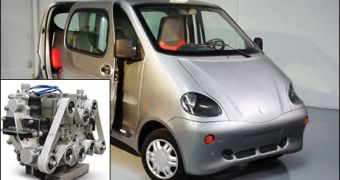This must be the crowning achievement in the field of alternative fuels. After the electric car and the one powered by hydrogen, this new product has the potential of successfully replacing the small city cars, which cause so much pollution.
It's called Air Car, it's developed by ex-Formula One engineer Guy N?gre, and will be built by India's largest automaker, Tata Motors. The name says it all. This car runs on compressed air!
No, it's not a joke. The Air Car uses compressed air to push its engine's pistons instead of fossil fuels. Don't be fooled by the looks of this car, because it can carry four passengers, has a top speed of 68 mph (110 km/h) and an autonomy of 125 miles (200 km).
You only need to find a gas station with custom air compressors in order to refuel this car. The refuelling takes only a few minutes and the cost of a fill up is approximately $2.00. Again, these figures are not a joke, they are posted on the manufacturer's website.
How exactly does compressed air propel this car? It's kind of like an electric car, only the compressed air is a way of storing electrical energy without the need for costly, heavy, and occasionally toxic batteries. Oh yeah, plus, it has no batteries!
The body is made of light-weight, glued-together fiberglass, so it won't break any records in terms of impact safety, but this won't stop this car from being produced to 12 more countries of the world, besides its native India, including Germany, Israel and South Africa.
The main advantage of this city mouse is the fact that its unusual fuel doesn't limit its use to only a few places, where those special fuels are available. The manufacturer offers two alternative ways of refuelling. The first is manual, so if a driver doesn't have access to a compressor station, they will be able to plug into the electrical grid and use the car's built-in compressor to refill the tank in about 4 hours.
The second is still under development, and it will be a hybrid version of the engine that would use an on-board, gasoline-powered compressor to refill the air tanks when they run low.

 14 DAY TRIAL //
14 DAY TRIAL //